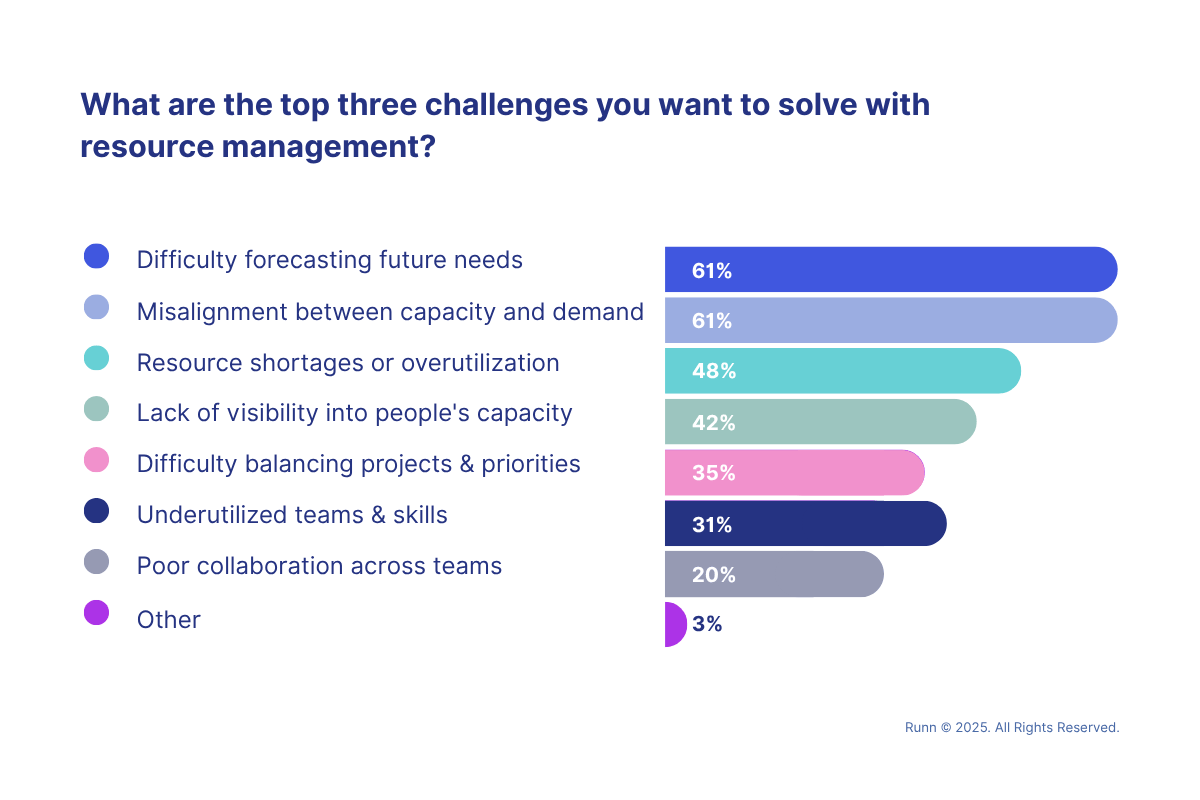Poor resource management is so often the factor holding back otherwise brilliant software and IT firms. Here’s the top five priorities to address ASAP.

Managing resources is a real challenge for many IT firms. Not just figuring out how to do it, but also knowing what’s available to help them.
And it matters. Because resource planning is at the heart of profitable project management. When it’s off, it creates a domino effect of missed deadlines, burned-out staff, dissatisfied clients, and squeezed margins.
In this article, you’ll find the five critical resourcing problems holding software and IT companies back (based on data from our 2025 State of Resource Management report) and what smart firms can do to fix them.
Resource management is important to custom software and IT solutions businesses because they aren’t just selling clients an end product.
They’re selling clients the promise of being able to deliver the end product. But that’s not guaranteed.
It depends on a complex interplay between the people, skills, and time available within the business. Combine those three elements effectively and:
But combine them poorly and:
(Forgive us if you know this already but…)
Managing this balancing act between people, projects, and business needs is known as resource management.
And for custom software and IT solution businesses, it is the difference between happy customers and healthy margins, and disappointment across the board.
IT and custom software solutions firms often have highly complex projects because of all the moving pieces. They’re juggling:
Meanwhile, you’ve got clients who have every right to expect the on-time, on-budget, on-scope project delivery they’ve hired you for.
And don’t forget the fact that ‘resources’ are, ultimately, human beings who get tired, stressed, and sick if they have too much work.
Plus, that’s just the operational side of resourcing IT projects. Above that is a whole other layer of strategic decision-making:
Bearing in mind that this is often done with restricted visibility into resource data, it’s no wonder many organizations struggle with resource management.
Fortunately, these challenges are surprisingly easy to solve if you have the desire and know-how. And we can help you with the know-how…
Resource visibility means your ability to see the resources available to you. Not just the basics like their availability, but the information you need to create strong project teams.
With this information, you can match:
However, many IT companies lack this essential resource visibility. In our recent State of Resource Management survey, 32% of respondents said ‘lack of visibility’ was their biggest barrier to effective resource management.
When resourcing is scattered across spreadsheets, project tools, email inboxes, and managers’ minds, you can't see what people are working on, how much time they have, or what they excel at.
This means talent discoverability is desperately low and your allocations aren’t as accurate as they could be, leading to:
All of which means avoidable delays, unnecessary costs, and risks to client and staff satisfaction.
The most effective way to address a resource visibility problem challenge is to bring all of your resourcing information into a single, central platform. The ideal solution should provide easy access to the information you need to make faster, more accurate resourcing decisions.
Skills management is an essential part of effective resource management. It’s about equipping resource managers/project managers with an up-to-date understanding of the expertise at their disposal.
Good skills management increases the accuracy of resource allocations, supports staff development and retention (reducing overall employee turnover costs) and informs capacity planning alongside strategic, skills-based hiring decisions.
Keep reading: Skills Tracking & Management 101 ➡️
However, getting the most out of skills management relies on establishing and maintaining the right kinds of processes:
And that doesn’t always happen.
When skills management is missing or ineffective, managers are limited to allocating resources based on their personal knowledge of the resource – or the typical duties associated with their role.
This could result in:
Either way, poor skills management is an expensive mistake for IT solution providers.
Perhaps this is why ‘underutilized skills’ is something 31% of firms say they want to solve, and 86% of companies are tracking skills or want to.

To improve your skills management and allocation accuracy, you need to implement appropriate technology and business processes. We suggest implementing:
Learn more: How to Perform a Skills Gap Analysis in Your Organization ➡️
If you’re one of the 58% of firms using spreadsheets for resource management, there's a good chance they're not working for you.
We understand the rationale behind using something like Excel or Google Sheets for resourcing. They’re free and familiar. But they’re just not fit for purpose — especially as your teams grow, your projects become more complex, and you want to plan further ahead.
Think about all the things you need to deliver projects better, like real-time visibility into resource availability, allocations, capacity, and skills. Or a way to automatically calculate utilization rates by individual, role, or team. Spreadsheets don't offer those capabilities, making it challenging to pick the right people for projects, create balanced workloads, and confidently do capacity planning.
But with so many firms still trying to make it work with spreadsheets, it's no wonder that struggling with inadequate processes and outdated tools was our survey respondents' top blocker to effective resource management.
The result isn't just frustration and time wasted for project or resource managers. Problems caused by inadequate tooling compound and impact project quality, staff retention, business reputation, and profit margins. Thankfully, there's a solution.
.png)
How to fix it
Manual work, data doubt, and lack of scalability… We won’t go on about the many reasons to ditch spreadsheets for resource management because you already know. But what you might not know is that resource management platforms exist to solve exactly these issues.
Resource management platforms provide an integrated view of resourcing in a single platform. Here are some resources to learn more:
Capacity forecasting is concerned with predicting how much work your people can take on – but it isn’t without its challenges.
In fact, forecasting future needs is the top challenge firms face when it comes to resource management, with 61% citing it as their biggest struggle. (Source: Runn State of Resource Management 2025 report)
Capacity forecasting ensures you can match supply (your people) to demand (client projects), and avoid costly problems like:
If you can get your capacity forecasting right, you can strategically plan your workforce, make cost savings, and create balanced workloads. Additionally, you can confidently seize opportunities when you know you have the staff and skills to spare.
But it does require reliable data, and, unfortunately, this is a stumbling block for many firms. Only 10% of managers we asked said that they had complete confidence in their data, with the majority of respondents attributing their data woes to issues around systems, tooling, and processes:
.png)
To improve your capacity forecasting, you need tools that deliver:

The whole point of resource management is to optimize how you use the resources at your disposal – to improve utilization, minimize wasted time and talent, and achieve broader business goals.
While it works well in individual departments, the benefits are amplified if you execute across the entire business. This means departmental silos are a problem because:
No wonder 31% of firms say siloed departments are one of their top project blockers, and 25% say decentralized processes. (Source: Runn State of Resource Management 2025 report). They want to minimize the many risks associated with fragmentation – from stressed staff and unhappy customers, to missed opportunities or missold projects.
To break down organizational silos, you need:
Resource management software like Runn helps you transform your approach to resource management. Make these changes today and begin unblocking project delivery: